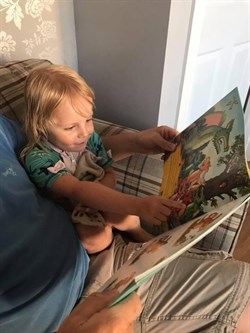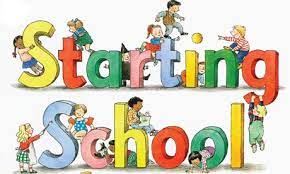Primary 1 Transition
Introduction
A child moving from nursery to primary 1 is such an exciting time. We thought we would share with you some activities that would help establish foundation skills from which further development in primary one can build on.
Many of the activities and skills that will be suggested may be things that you and your child are already doing and therefore it is hoped that the information that we provide is good for reassurance. For some it may be a useful guide of some fun and developmentally appropriate activities to try.
Functional skills such as dressing, using cutlery, going to the toilet, drawing/pre-writing are useful skills to practice as well as movement skills such as gross motor and fine motor activities.
There is certainly no pressure or expectation as teachers will be aware that some children will be more able than others when they go to school and will of course assist and encourage your child where necessary. It is however useful for teachers if children are given the opportunity and encouragement to practice some everyday skills prior to entering primary 1.
There is no need to think about reading and writing letters and numbers as this will be taught at the appropriate stage. The skills that are most important at a pre-school stage are those that provide the ‘building blocks’ or ‘foundations’ for academic learning, and those that encourage more independence with functional tasks.
We hope that those of you with children who are at this stage find the following information useful!
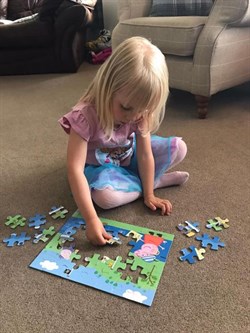
Dressing Skills
When children learn how to dress themselves it is a huge accomplishment. Independent dressing is a skill that needs to be taught and practiced.
The following tips will hopefully help both you and your child feel more confident with getting ready for school, and with changing for gym at school.
Things to consider:
• Introduce dressing by using dressing toys, dress up costumes and imaginative play
• Encourage the child to handle clothes. They can help to hang out clothes, or sort clothes into colours and types
• Find a routine that suits you and your child. If weekday mornings are busy, it may be easier to practice at bedtimes or at the weekends
• Lay clothing out in the correct sequence
• Start with undressing, as this is easier and can be done later in the day as part of the bedtime routine
• Ideally, they should be seated on a chair or a stool where they can put their feet flat on the floor. If the child is quite small, using the bottom step on a set of stairs may be easier
• Talk through dressing, naming items and describing what you are doing
• Initially, the child should try putting on socks, or pulling up trousers. Use a slightly bigger size clothing for top half to make it easier
• Place a large mirror in front of the child
when dressing so they can see what they are doing
• If a child refuses to dress themselves, you could use a reward chart system to encourage participation and ultimately independence
• Consider clothing that would make it easier for your child at school, i.e. elastic waistbands, Velcro shoes, elastic laces, larger polo shirts or toggles/ribbon on zips
Often labels are at the back of clothing and this can be a useful guide to get clothing the right way round
Tips for mastering zips and buttons;
• Practice with large buttons while clothing is not on body. If you have any outgrown clothing with buttons, cut the hole a little wider to make it easier and to give more chance of success whilst practicing
• Practice doing zips and buttons with the clothing placed on a table in front of the child. Clothing placed in the same direction that it would be on the child’s body i.e top of the clothing nearest the child whilst child seated at table (see picture below). This keeps the clothing stable, and allows the child to see exactly what they are doing.
• Attach toggles or thin ribbon to zips so children can see the zip, and grip it more easily.
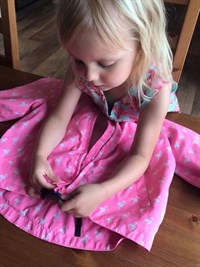
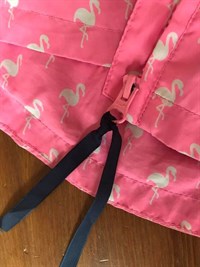
Tip for putting on coat
A simple and effective way to put on your coat!
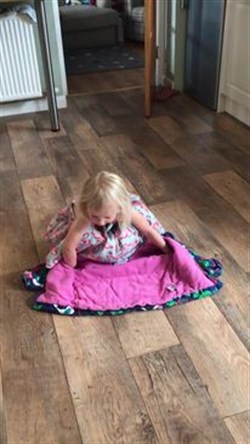
Tip for putting shoes on the right feet
Try cutting a sticker in half and putting each half on the inside part of the insole so that the child places their shoes ready to put on by matching up the stickers. Alternatively try drawing a dot or half a shape on the inside part of the insole using permanent pen.
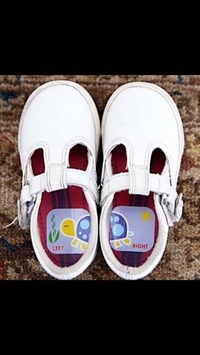
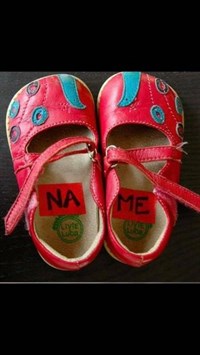
Backward Chaining
Backward chaining (practicing the last step until mastered, then adult gradually reducing how much help you give)
• Backward chaining means that a task of dressing is broken into steps.
• An adult provides assistance throughout several steps until the child can complete the last steps independently.
For example – socks:
o The adult places the sock over the child’s toes (step1), then over their heel (step 2) and encourages them to pull the sock up their leg (step 3) - first photo
o Once they are able to pull the sock up on their own (step 3), encourage them to pull the sock over their heel and up (step 2 and 3) - second photo
o Finally, they will pull the sock over their toes and heel and up their leg (step 1, 2 and 3) - third photo
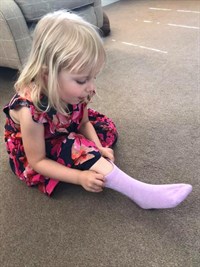
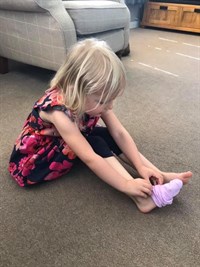
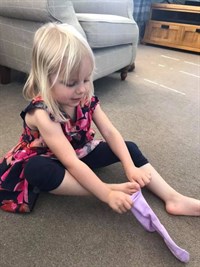
Tips for turning clothes the right way round
Practice turning inside out clothing the right way round
Help your child feel more confident when changing at gym time by practicing turning inside out clothing the right way round. Talk through reaching inside the t-shirt to turn it the right way, then give lots of opportunities to practice.
Turn practicing this skill into a game. Line up t-shirts that are inside out and have your child turn them the right way round giving a token reward for each t-shirt. They will enjoy earning & counting their tokens and the repetition will help them learn & improve in their ability.
Start by practicing with vests (no sleeves to think about) then move onto t-shirts, and then long sleeve tops.
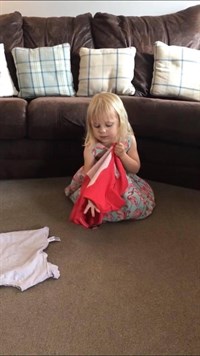
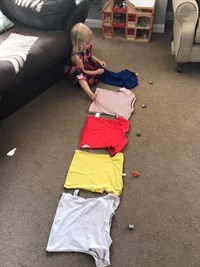
Fine Motor Skills
We use our hands on a daily basis for a variety of activities. The way in which a child uses their hands needs to be appropriate to each task. Development of fine motor skills can improve the way a child manipulates things and therefore has a positive impact on their ability with every day functional tasks such as getting dressed, using cutlery, using technology and drawing. Your child will be developing their fine motor skills every day without even thinking about it through play. Another great reason why play is so important in a child’s development and should always be encouraged at this stage. At age 4/5 encourage them to refine their skills by using smaller toys/materials.
Below are some pictures of toys/materials that can be used to develop fine motor skills.
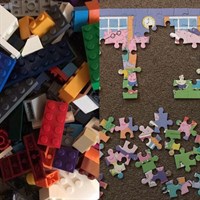
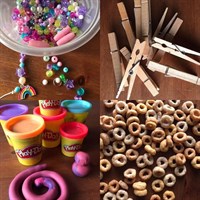
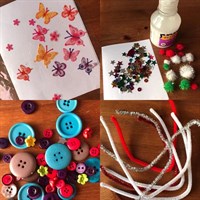
Fine motor skills is the term used to describe movements in the hand, in particular the more refined movements in the fingers and thumbs. For fine motor skills to become established a child needs to develop pincer grasp, in-hand manipulation, hand strength and using 2 hands together.
Hopefully you will have some things at home that you can use to help develop fine motor skills, though as previously mentioned, children use fine motor skills in every day play and are developing this skill without thinking about it.
Activities to develop pincer grasp:
• peg boards
• craft activities e.g gluing sequins, using pipe cleaners, jewellery making, using dry pasta to make pictures
• sorting small items such as buttons into containers
• board games with counters
• peeling stickers
• pegging clothes pegs onto things- could turn this into a timed activity
• picking up and putting coins in a piggy bank
• pinching off small pieces of play dough and rolling it between fingers to make small balls
• jigsaws
In-hand manipulation:
Any activity that requires the child to pick up a small item and move it in the same hand before placing accurately e.g pegs into a peg board, coins into a piggy bank, using one hand only-picking up a few coins at once and keep them in the palm of your hand whilst putting them one-by-one in a piggy bank
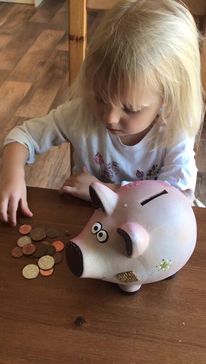
Activity ideas to work on hand strength:
• playdough, plasticine, modelling clay, putty
• squeezing water bottles
• using spray bottles
• squeezy/stretchy balls
• wheelbarrow walks and crawling activities
• tearing card
• using a hole punch
• glitter glue tubes
• using tongs or tweezers
• popping bubble wrap
• crumpling up paper to make a ball
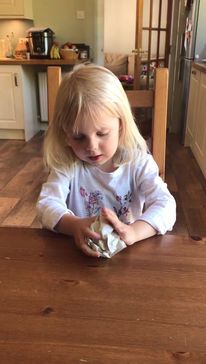
Activities to work on Bilateral Integration
Both sides of the body needs to work together in a coordinated way for many functional every day tasks. Practicing activities that need 2 hands to work together will help both sides of the body to ‘connect’ and will improve fine motor skills.
Activity ideas for using 2 hands together:
• clapping games
• pouring water/dry sand from one container to another
• threading beads/buttons- start off with pipe cleaners if child is finding it tricky with lace
• lacing cards
• making paper chains
• rolling out & making models with play dough
• opening/closing jars, bottles, tubes, nuts and bolts
• construction toys such as Lego
• craft activities
• throwing & catching a ball
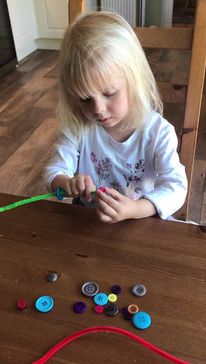
Pre-Writing Skills
Before a child learns to write they need to carry out pre-writing activities which are the ‘building blocks’ necessary for eventually learning to write. The skills that need to be developed include fine motor skills (see previous posts), eye-hand coordination, body posture, motor planning and visual skills. In every day play and activities, your child will be developing these skills without even thinking about it.
Activity ideas:
• fine motor activity ideas as outlined above, in order to develop pincer grasp which will help in the development of a functional pencil grasp, hand strength, and using both hands together (needed for writing when one hand holds the pencil and the other hand holds the paper steady.
• use damp sand, shaving foam, finger paint, wet finger on blackboard and encourage child to use index (pointy) finger to draw. This will develop skills in mark making, direction and fine motor control without having to hold a drawing tool (pencil, pen, crayon).
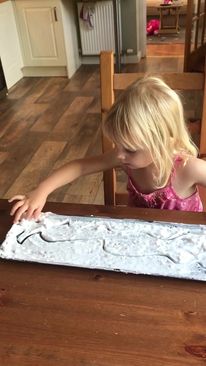
Try drawing on a variety of different surfaces with finger and with writing tool. Surfaces such as the floor, vertical surface, even try sticking a sheet of paper under a table so the child is reaching up to draw. This helps develop body posture, stability and shoulder strength.
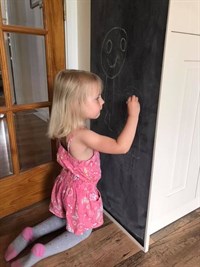
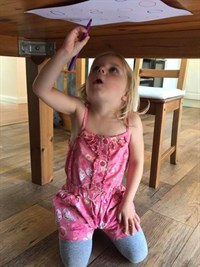
• crayon rubbings over different surfaces e.g tree trunk, paving slabs, decking etc.
• painting
• colouring books
• mazes and patterns
• drawing round shapes/templates
• free drawing
• magnetic drawing board
• copying simple shapes and patterns
Encourage your child to pick up pencils/pens often and just draw!!
If your child had difficulty holding pencil/pen try using chunky ones
Make your child aware of working from left to right through drawing patterns this way as this is the direction we read and write in
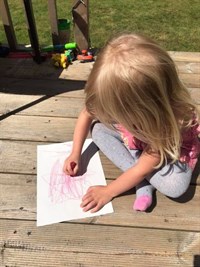
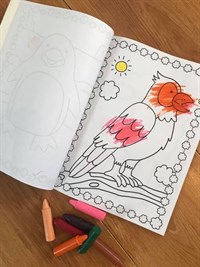
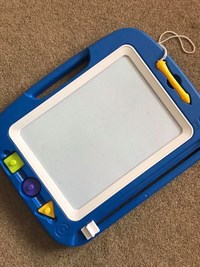
Meals and Snacks
This is a great time to practice some skills that may give your child more confidence at meal and snack times at school.
Activity ideas and strategies:
• the snacks that you give your child for playtime may be in packets or wrappers. Give your child opportunities to practice opening packets and wrappers (school staff will help but children might like to practice this)
• if your child takes a water bottle to school make sure it is one they can open. Practice opening/closing if needed
• give your child opportunities to practice pouring water from a jug
• baking with your child using cutters, spoons to add ingredients and stir mixture, knife to mark dough etc.
Some children might already be able to use cutlery and others may not be quite at this stage.
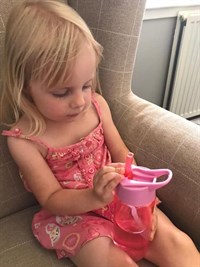
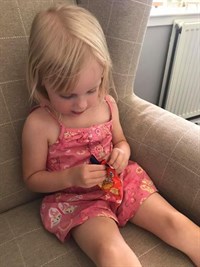
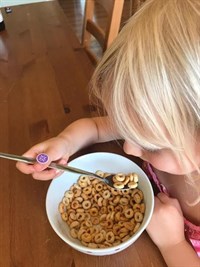
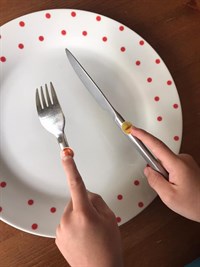
use tippex or stickers on cutlery to prompt where to place index (pointy) finger on cutlery
• child may need to start with small chunky cutlery before progressing to adult cutlery
• if your child turns fork/spoon upside down when it reaches their mouth place a sticker somewhere on child’s hand and ask them to focus on this from the point they pick up the food to putting it into mouth
• when practicing using a knife and fork together start with foods that are easy to cut up such as fish fingers, bread and butter, hotdogs
•using play dough- ask the child to roll out the play dough into a sausage (rolling play dough is also good for developing coordination of using 2 hands together necessary for using a knife and fork together together)
• use the fork to stab and make fork marks in the sausage
• progress to holding the fork in place after stabbing the play dough and use a cutting action with knife
• if possible have cutlery available whenever your child asks to play with play dough so that they can choose to incorporate it into their play
Gross Motor Skills
Gross motor skills are those which require whole body movement and which involve the large muscles of the body to perform everyday functions, such as standing, walking, running, and sitting upright.
Participation in gross motor play develops the following:
• Core strength (tummy muscles, back muscles, muscles that support our shoulders and hips)
• Fluency of movement
• Hand-eye coordination
• Motor control
• Bilateral coordination (using both sides of the body together)
Development of the above helps with sitting upright in a chair, dressing, riding a bike, stabilising a pencil and outdoor play.
In every day play (running around, jumping, rolling, changing positions, playing with a ball, playing outdoors) your child will be developing gross motor skills without even thinking about it.
Play games on the floor or in high kneeling at a small table
• play musical statues
• make obstacle courses with things you have in the house or garden
• jump like a bunny, kangaroo, walk like a cat, dog, walk sideways like a crab, slither like a snake etc.
• play a copying positions and movements game such as ‘Simon says’ - stand on tip-toes, wide like a star etc.
• encourage child to reach to opposite sides of body i.e right hand touching left knee
• on hands and knees, lift up one arm at a time, then one leg at a time, then try one arm and one leg at same time
• wheelbarrow walks with partner
• log rolling and forward rolls
• riding a bike/trike
• playground equipment when possible- climbing, swings, slide, roundabout
• walking along a skipping rope/plank etc. to improve balance
There will be many naturally arising opportunities indoors and outdoors where the child will incorporate these movements into their play.
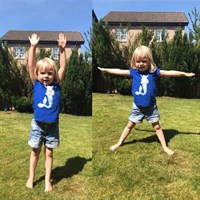
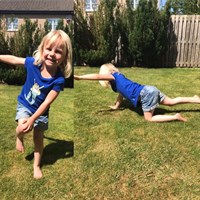
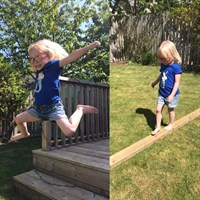
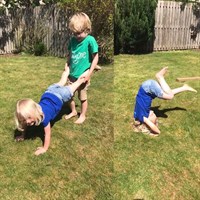
Ball skills
This requires a combination of motor skills including core stability, motor control, eye-hand coordination and visual skills. Practicing ball skills may increase your child’s confidence to participate in team games. Your child will benefit from being given plenty of opportunities and time to play with a variety of balls.
Activities to try:
• catch and pop bubbles
• roll a ball around your body
• start with rolling a ball along the floor as the ball moves slower and therefore easier to coordinate eye and body movements
• play skittles with beanbags initially, moving onto using a ball
• use a balloon to practice catching/keeping it up in the air (slower moving)
• practice bouncing a ball with no expectation to catch, then progress to attempting to catch
• throwing and catching games with a variety of sizes of balls (start with bigger balls & progress to smaller ones)
• play football
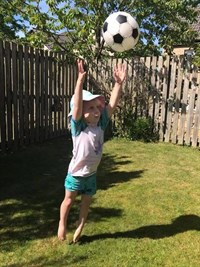
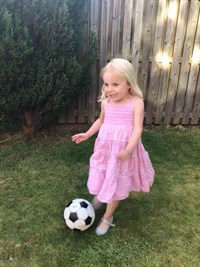
We really hope that you have found these ideas useful, these are simple activities and practical skills to try so that a child can develop the ‘building blocks’ or foundations from which further development in primary one can build on. Other useful things to practice are; going to the toilet and learning to wipe themselves after, and brushing teeth. It is also really beneficial if grown ups read to children frequently as not only is this a lovely thing to do with your child, it is their starting point for eventually learning letters and words, and understanding language.
Your child may already be able to carry out many of the activities and skills, but for others we hope this has been a useful guide of appropriate things to try! There is no pressure or expectation as teachers are very aware that children go into primary 1 with varying levels of ability and will encourage, support and enable your child accordingly. These are simply ideas of things that you and your child might like to try!
Additional Resources
- Our service have developed this booklet, which can be downloaded and looked through at home, which may supplement some of the activities and ideas mentioned here.
- Please also follow our Facebook Page which is really busy with lots of ideas and things to try with your little one.
Our service wish you and your child(ren) all the very best with their transition to Primary 1
